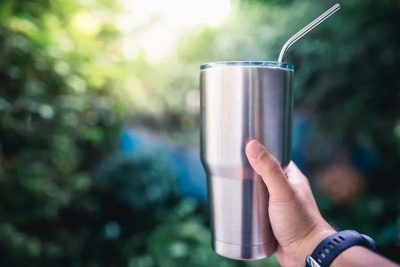Stainless steel cups, mugs, tumblers and other drinkware are extremely popular due to their desirable attributes. They keep drinks hot or cold, are lightweight and doesn’t shatter like normal ceramic or glass cups. But recent studies have shown that they might not be as safe as people think.
One important reason why stainless steel drinkware is so common is also because of the perception that it is safe to drink from. Stainless steel is inert. This means that it does not react to our food and beverages including acidic ones such as tea or lemon juice. Stainless steel is unlike other metals which will still slowly react with the acids, creating chemicals that could be harmful to our health.
However, this is unfortunately not always true.
Not All Stainless Steel Cups Or Tumblers Are Made Equal
Stainless steel comes in many different grades of which 304 stainless steel and 201 stainless steel are the most commonly used in drinkware. 201 stainless steel is cheaper but is less resistant to corrosion and rusts more easily than 304 stainless steel.
Recent studies have found that prolonged storage of acidic drinks which include fruit juices, tea and coffee in stainless steel containers result in significant leaching of metals such as nickel and chromium into the drinks (http://www.electrochemsci.org/papers/vol10/100503792.pdf). Nickel and chromium can cause adverse effects on a person’s health. Nickel itself is one of the most common cause of allergic contact dermatitis. Chromium when ingested can increase cancer risk, particularly lung cancer.
The findings from these studies also show a correlation between stainless steel grade and the level of metal leaching with 201 stainless steel being more susceptible to the corrosive effects of acidic drinks.

Which Stainless Steel Grade Is Safe?
304 stainless steel, which is considered food-grade, is the minimum grade we recommend for your drinkware. The disconcerting thing is that drinkware made from 201 and 304 stainless steel look very similar and even experts might have a difficult time trying to tell them apart. Buying from a reputable brand is therefore very important.
304 stainless steel is not entirely safe either. Studies do show that a longer cooking duration resulted in the concentration of nickel increasing by 34 times while chromium increased 35 times (https://www.ncbi.nlm.nih.gov/pmc/articles/PMC4284091/). Furthermore, acidic drinks and food at higher temperatures are particularly effective at corroding stainless steel (https://pubmed.ncbi.nlm.nih.gov/1514841/).
A thin layer of chromium oxide on the surface of stainless steel is actually what makes it corrosion resistant. The chromium in stainless steel forms chromium oxide when it is exposed to oxygen. This protective chromium oxide layer even reforms when stainless steel is scratched making it a very useful material.
However, during prolonged exposure to acidic drinks, organic acids are constantly attacking what’s protecting the stainless steel and the chromium oxide layer might not have a chance to heal before the acids corrode the stainless steel itself.
One thing that all scientific studies agree on is that acidic drinks and food will cause metal leaching when placed in contact with stainless steel containers. But the exact conditions and parameters that will result in a level of metal leaching that is harmful to our health still require further research.
The danger of harmful metal leaching is definitely present especially if the stainless steel drinkware you are using is not of high quality. That much has been proven by scientific studies.
Stainless Steel Do Rust
Many people believe stainless steel do not rust, but they do. Search online and you will find many articles talking about stainless steel rusting and how to remove rust from stainless steel. In fact, we have already talked about the reason why stainless steel rust. It is due to the protective chromium oxide layer being damaged.
Personally, we would rather not take the chance of our cups or tumblers rusting. Any rust that appear might also not be obvious making it even more dangerous.
Find out more about why stainless steel rusts: https://www.polymersolutions.com/blog/why-does-stainless-steel-rust/
Why Does My Stainless Steel Drinkware Have A Smell?
Apart from the grade of the stainless steel, another attribute to consider is how rough or smooth the surface of the stainless steel is. Stainless steel cups and tumblers with a rougher brushed interior are more porous and will trap liquids and chemicals. This results in you being able to smell the soap, tea or other beverages you might have drank days ago in your new freshly brewed coffee.
Not a good drinking experience and definitely a warning sign. How hygienic can it be if you are drinking the residue of whatever was in your stainless steel drinkware from last week?
There are many tutorials online on how to get rid of the smell from stainless steel mugs and tumblers. But we definitely recommend getting a high quality stainless steel drinkware with a well-polished and mirrored interior that doesn’t have this problem in the first place.
So Is Any Stainless Steel Drinkware Safe?
The Steelceramics cup is made from stainless steel with a proprietary ceramic coating on the inside. By completely sealing up the stainless steel, it eliminates all the weaknesses of stainless steel that we have discussed earlier. With no metal leaching, rusting and no metallic or residual smell, the Steelceramics cup has all the advantages of a stainless steel drinkware without the weaknesses.










